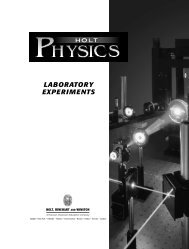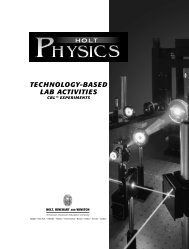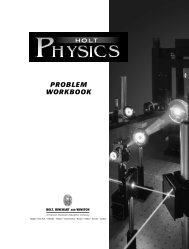LABORATORY EXPERIMENTS
Lab Experiments - langlopress.net
Lab Experiments - langlopress.net
- No tags were found...
You also want an ePaper? Increase the reach of your titles
YUMPU automatically turns print PDFs into web optimized ePapers that Google loves.
HOLT PHYSICS Safety in the Physics Laboratory, continued<br />
year; this will allow you to continue to raise the standard of safety in your<br />
classroom. Do not perform any activities in a classroom or laboratory until<br />
you can verify that it is safe and you are prepared to respond to emergency<br />
situations.<br />
Monitoring activities for safety<br />
Once the laboratory is reviewed and all safety issues are corrected, turn your<br />
attention to the activities that will be performed in class. The Invention Labs<br />
in this booklet require careful attention to safety, and all initial plans should<br />
be reviewed for possible safety concerns. Students should not be allowed to<br />
work in the lab until their proposed plans have been reviewed and approved<br />
from a safety standpoint. Every teacher should review all experiments,<br />
demonstrations, and activities for safety concerns before presenting them to<br />
the class. The goal of this review is to identify and eliminate potential safety<br />
hazards. In this way, you can maximize learning while minimizing risk and<br />
be prepared in case a safety issue arises during the activity.<br />
All reviews should be carried out in the following four stages.<br />
1. Identify the risks<br />
Before introducing any activity to the class, analyze the activity, and ask<br />
yourself what could go wrong. Try to consider all possibilities, no matter<br />
how unlikely they may seem. Carefully review the list of materials called for<br />
to make sure they are safe. Inspect the apparatus in your classroom to make<br />
sure they are in good working order. Read the procedures to make sure they<br />
are safe. Record any hazards or concerns you identify in a safety log.<br />
2. Evaluate the risks<br />
The focus of this step is to minimize the risks you identified in the last step<br />
without sacrificing learning. Weigh the pedagogical value of the activity<br />
against the safety risks. Remember that no activity you can perform in the<br />
lab is worth risking injury. Thus, extremely hazardous activities or those that<br />
violate your school’s policies must be eliminated. For activities that present<br />
smaller risks, analyze each risk carefully to determine its likelihood. This can<br />
be difficult because of the scarcity of documented cases of lab accidents.<br />
Using your best judgment and available information, estimate the probability<br />
of occurrence for each risk. If the pedagogical value of the activity does<br />
not outweigh the risks, the activity must be eliminated.<br />
3. Select controls to address risks<br />
Even low-risk activities require controls to eliminate or minimize the risks.<br />
Be careful that in devising controls you do not substitute an equally or more<br />
hazardous alternative. If no reasonable controls can be devised, eliminate the<br />
activity. Some control methods include the following:<br />
HRW material copyrighted under notice appearing earlier in this book.<br />
T18<br />
HOLT PHYSICS Laboratory Experiments Teacher’s Edition





